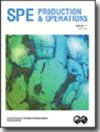海底油气设备中被困液体热膨胀导致压力上升的预测中期报告
IF 1.3
4区 工程技术
Q2 ENGINEERING, PETROLEUM
引用次数: 0
摘要
本文的目的是提出一种利用计算流体动力学(CFD)来预测由于被困液体的热膨胀而引起的压力上升的方法。本研究还对石油和天然气工业中广泛使用的各种压力累积计算方法进行了比较。将标准热力学计算与瞬态三维CFD分析进行比较,发现瞬态CFD分析可以更深入地了解圈闭体积的温度和速度场。该方法的应用不仅限于海底油田的单个组件/设备,还可以应用于海底设备中的任何被困体积。在本研究中,为了演示目的,展示了海底采油树(XT)井下(DH)端口的压力累积;同样的方法可以扩展到其他设备或感兴趣的区域。由于缺乏关于被困流体热膨胀引起的压力上升的文献,工程师被迫在不知道每个项或参数对最终计算压力的影响的情况下做出几个假设。在本研究中,还详细讨论了使用标准解析压力上升方程的各种形式的最终压力的百分比变化/变化。本文章由计算机程序翻译,如有差异,请以英文原文为准。
An Interim Report on Predicting Pressure Rise due to the Thermal Expansion of Trapped Liquids in Subsea Oil and Gas Equipment
The objective of the present work is to propose a methodology to predict pressure rise due to the thermal expansion of trapped liquids using computational fluid dynamics (CFD). The present study also provides a comparison between the various methods used for pressure buildup calculations that are widely used in oil and gas industries. A comparison of standard thermodynamic calculations with transient 3D CFD analysis reveals that transient CFD analyses can provide deeper insights on the temperature and velocity fields in trapped volumes. The application of the proposed method is not just restricted to a single component/equipment in the subsea field but can be applied to any trapped volume in subsea equipment. In the present study, the pressure buildup in a downhole (DH) port of a subsea Christmas tree (XT) is presented for demonstration purposes; the same methodology can be extended to other equipment or regions of interest. Because of a lack of literature on the topic of pressure rise due to thermal expansion of trapped fluids, engineers are forced to make several assumptions without knowing the effect of each term or parameter on the final pressure calculated. In this study, the percentage change/variation of the final pressure using the various forms of a standard analytical pressure rise equation is also discussed in detail.
求助全文
通过发布文献求助,成功后即可免费获取论文全文。
去求助
来源期刊

Spe Production & Operations
工程技术-工程:石油
CiteScore
3.70
自引率
8.30%
发文量
54
审稿时长
3 months
期刊介绍:
SPE Production & Operations includes papers on production operations, artificial lift, downhole equipment, formation damage control, multiphase flow, workovers, stimulation, facility design and operations, water treatment, project management, construction methods and equipment, and related PFC systems and emerging technologies.
 求助内容:
求助内容: 应助结果提醒方式:
应助结果提醒方式:


